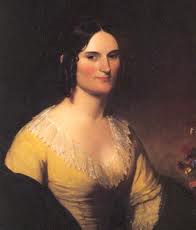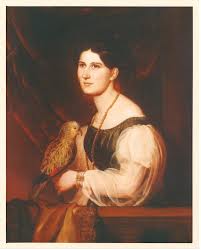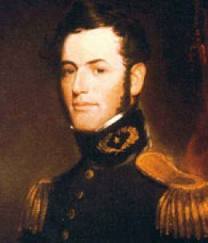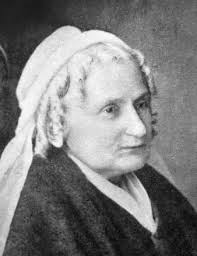 Virginia Royalty, Mary Custis Lee, was not only a wealthy and privileged Confederate Queen, but the wife of CSA Commanding General Robert E. Lee. Mary Custis Lee, great-granddaughter of First Lady Martha Washington, has been often portrayed in a negative light. It has been related that her arthritis turned her into a constant complainer. Such conclusions were arrived at based on a few select comments taken out of context from letters her husband wrote to her. Actually, as a descendant of Virginia’s First Family, Mary Custis Lee was a courageous, selfless, creative woman who managed to solely, for the most part, raise seven children while battling many physical ailments. Although she may have spent years walking in the shadow of her husband, in reality she was a guiding light and a pillar of strength, not just during Virginia’s darkest days and that of the Confederacy, but throughout much of her life.
Virginia Royalty, Mary Custis Lee, was not only a wealthy and privileged Confederate Queen, but the wife of CSA Commanding General Robert E. Lee. Mary Custis Lee, great-granddaughter of First Lady Martha Washington, has been often portrayed in a negative light. It has been related that her arthritis turned her into a constant complainer. Such conclusions were arrived at based on a few select comments taken out of context from letters her husband wrote to her. Actually, as a descendant of Virginia’s First Family, Mary Custis Lee was a courageous, selfless, creative woman who managed to solely, for the most part, raise seven children while battling many physical ailments. Although she may have spent years walking in the shadow of her husband, in reality she was a guiding light and a pillar of strength, not just during Virginia’s darkest days and that of the Confederacy, but throughout much of her life.
Mary Anna Randolph Custis was born on October 1, 1808, to parents Washington “Wash” Custis and Mary “Molly” Fitzhugh, at Annfield, in Frederick County, Virginia. Wash Custis, who was the grandson of Martha Washington and was raised by her and George Washington after his father’s (Martha’s son from a previous marriage) death, settled his family in a quaint four-room brick home he named Arlington.
Mary’s earliest Virginia memories at Arlington are recalled with fondness. Although she was an only child, she usually found willing playmates among the children of the Arlington slaves. It’s interesting to note that neither Wash nor Molly supported or believed in slavery. Although both felt it was wrong to own another human being, they wondered if the slaves were free, how would they support themselves? They couldn’t read, write, and didn’t own any property. Molly, like many abolitionists, set out to change that and offered both educational and Sunday school classes to the slaves of Arlington in preparation for the day they would be free. In later years, Wash was instrumental in founding the American Colonization Society, a society with the goal of freeing the slaves and funding their return to Africa. Over the course of the society’s existence, about 6,000 slaves had been freed and returned to Africa.
 Mary Custis was given an unusually fine education. Her studies emphasized history, literature, and philosophy, as well as Greek and Latin. A French tutor made special mention of Mary’s “incomparable qualities,” and she also excelled at drawing, for which she had a marked talent.
Mary Custis was given an unusually fine education. Her studies emphasized history, literature, and philosophy, as well as Greek and Latin. A French tutor made special mention of Mary’s “incomparable qualities,” and she also excelled at drawing, for which she had a marked talent.
Her most notable education, however, came through exposure to America’s greatest personalities at her father’s estate, Arlington. Situated across the Potomac River from the nation’s capital, Arlington was designed to house the Washington memorabilia that Custis had amassed. Custis also had a rich store of anecdotes about his grandparents, and people traveled considerable distance to hear his reminiscences. As a result, Mary grew up conversing with leaders such as John Marshall and the Marquis de Lafayette. These experiences fostered a keen interest in politics and culture that never left her.
 Those who knew Mary never described her as having a distinguished outer beauty, she had inherited her father’s sharp nose and chin, but they were captivated by her grace, charm and wit. During her late teens, she was considered a social butterfly and many were drawn to her magnetic personality. At 17, she was introduced to, and briefly courted by, 32-year-old, dashing Sam Houston. Her heart was unmoved. Instead, her joy was founded in a man she’d known since childhood. His name was Robert E Lee. The two were distantly related and often played together at the Ravensworth Virginia estate, which was owned by William Fitzhugh, Mary’s uncle.
Those who knew Mary never described her as having a distinguished outer beauty, she had inherited her father’s sharp nose and chin, but they were captivated by her grace, charm and wit. During her late teens, she was considered a social butterfly and many were drawn to her magnetic personality. At 17, she was introduced to, and briefly courted by, 32-year-old, dashing Sam Houston. Her heart was unmoved. Instead, her joy was founded in a man she’d known since childhood. His name was Robert E Lee. The two were distantly related and often played together at the Ravensworth Virginia estate, which was owned by William Fitzhugh, Mary’s uncle.
When Lee proposed to her in the summer of 1830, Mary accepted and the Lees married in the family parlor at Arlington House on June 30, 1831. Their marriage produced seven children, six of them born in the dressing room adjoining the Lee’s bedroom, according to family tradition. From all appearances, the Lees had a warm and loving family life.
Closely following her mother’s example, Mary Lee was very religious. She and her family attended an Episcopal church near army posts where ever they were stationed, and when they were at Arlington, the Lees usually attended Christ Church in Alexandria, the same church that both Mary and Robert had attended in their childhood. Mary followed the Custis family tradition of having family prayers after breakfast and each evening in the family parlor.
During her adulthood, Mary developed severe rheumatoid arthritis and became increasingly debilitated as she grew older. To help with the pain, Mary and her family often visited many spas and springs that were reputed to improve health. In letters to her husband, she tried to downplay her illness, but it took its toll as the years passed. By the 1850s Mary organized her daily routine so that she climbed the stairs only twice each day, coming down in the morning and going back up at bedtime. Upon the outbreak of the war, she was walking with difficulty and by the end of 1861 she was confined to a wheelchair,no doubt due to in part to her nomadic existence, moving from plantation to plantation and the stress of not knowing what was happening to her husband and sons.
When Virginia joined the Confederate States of America at the beginning of the Civil War, Robert E. Lee resigned his commission with the federal army and accepted a commission in the army of Virginia. Mary wrote her daughter,
“With a sad and heavy heart, my dear child, I write, for the prospects before are sad indeed. And as I think both parties are in the wrong in this fratricidal war, there is nothing comforting even in the hope that God may prosper the right, for I see no right in this matter. We can only pray that in His mercy He will spare us.”
With some delay, Mary Custis Lee was convinced to pack up many of the family’s belongings and move out of the home at Arlington, because its nearness to Washington, D.C., would make it a target for confiscation by the Union forces. And so it was, for failure to pay taxes, though an attempt to pay the taxes was apparently refused. Mary spent many years after the war ended trying to regain possession of her Arlington home. Robert returned after the surrender of the Confederacy and they moved to Lexington, Virginia, where he became president of Washington College. Mary’s son Robert wrote of his mother’s deteriorating condition,
 “She was a great invalid from rheumatism, and had to be lifted wherever she moved. When put in her wheelchair, she could propel herself on a level floor, or could move about her room very slowly and with great difficulty on her crutches, but she was always bright, sunny-tempered, and uncomplaining, constantly occupied with her books, letters, knitting, and painting.”
“She was a great invalid from rheumatism, and had to be lifted wherever she moved. When put in her wheelchair, she could propel herself on a level floor, or could move about her room very slowly and with great difficulty on her crutches, but she was always bright, sunny-tempered, and uncomplaining, constantly occupied with her books, letters, knitting, and painting.”
Neither Robert E. Lee nor Mary Custis Lee survived many years after the end of the Civil War. He died on October 12, 1870. Mary wrote after her husband’s death,
“We all sat up all night every moment almost expecting to be his last. He lay breathing most heavily and the Dr. said entirely unconscious of pain. I sat with his hand in mine all moist with heavy perspiration, and early in the morning and went into my room to change my clothes and get a cup of tea. When I went back he lay in much the same condition, only there were some more severe struggles for breath — these became more frequent and intense and after 2 very severe ones, his breath seemed to pass away gently, and he so loved and admired now lies cold and insensible.”
Severe arthritis plagued Mary Custis Lee the rest of her life and she died in Lexington, Virginia, on November 5, 1873, after making one last trip to see her old home at Arlington. In 1882, the U.S. Supreme Court in a ruling, returned the home to the family, but Mary and Robert’s son, Custis, sold it back to the government.
Robert and Mary rest side by side in the Lee Family Crypt on the campus at Washington and Lee University in Lexington, Virginia.
Bummer


Never knew the Lee family got Arlington back; my understanding was that by war’s end it already had so many soldiers’ graves that there was no way it could be given up.
Louis,
“Custis took to fighting for the return of Arlington and in 1882 the Supreme Court ruled that Arlington had indeed been illegally taken and ordered it returned to the family. Custis, the legal heir, had no desire to live among dead and sold it to the government for $150,000, half its estimated value.”
Bummer